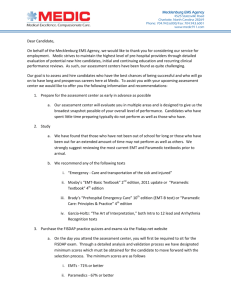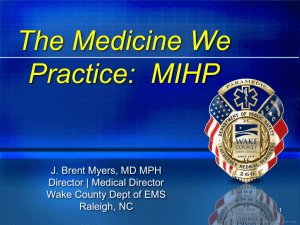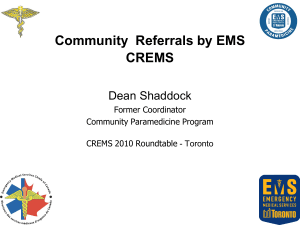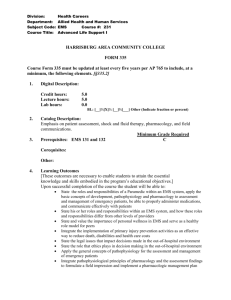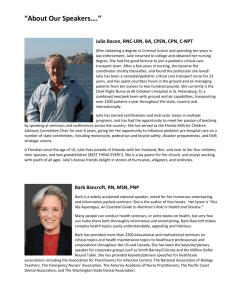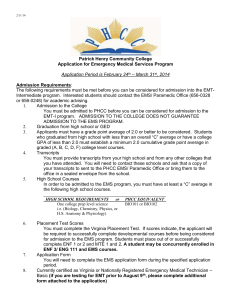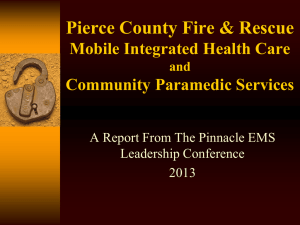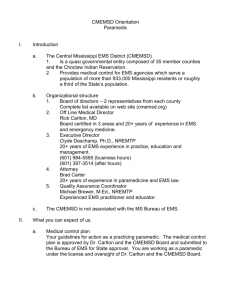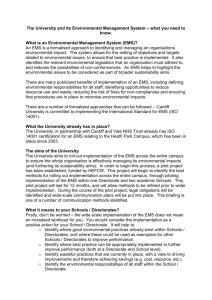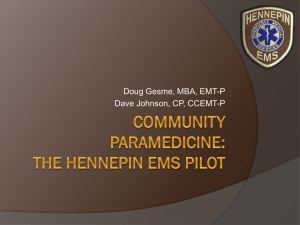Fire Based EMS
advertisement
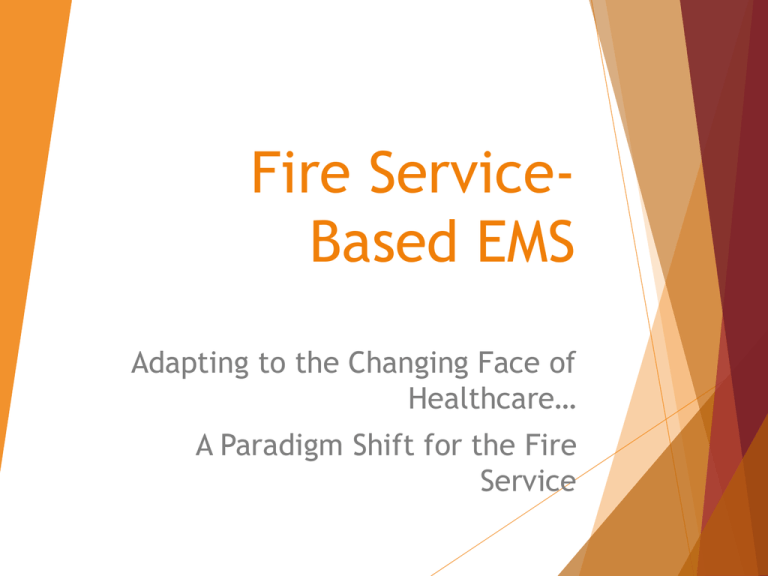
Fire ServiceBased EMS Adapting to the Changing Face of Healthcare… A Paradigm Shift for the Fire Service What We Know The Affordable Care Act is accomplishing the following: Reducing the number of uninsured in America Enhancing the level and quality of primary care providers to citizens Providing expanded benefits to covered individuals What We Know Not enough Primary Care Providers The Emergency Department fills voids but is expensive Accountable Care Organizations (ACOs) Our New Environment: • ACA tipped the 1st domino New partnerships/New opportunities Aligned incentives & risk sharing Bundled payments based on episode of care Payment based on OUTCOMES Our New Environment: Example There are 4.6 million Medicare beneficiaries with CHF 14% of beneficiaries have CHF 43% of Medicare spending on CHF One CHF admission cost CMS $17,500 30‐day readmission rate for CHF = 24.7% Patients do not see their doc between discharge and readmit = $12 billion CMS expenditures for Potentially Preventable Readmissions Mobile Integrated Health- Community Paramedic National Perspective Mobile Integrated Health Focus on patient-centered navigation and transparent population specific care Operates through population-based needs assessments Leverage multiple strategic partnerships under physician medical oversight Multidisciplinary and inter-professional teams Community Paramedic Defined Licensed/ Certified Paramedic with Additional Training Physiology, disease processes, injury and illness prevention, and medical system navigation Population Public health services to elderly, underserved, and chronic condition- primary care and social services Health Care health assessment, chronic disease monitoring, education, medical care and prescription regime compliance, immunizations and vaccinations, laboratory specimen collection, hospital discharge follow-up care, and minor medical procedures MIH-CP Defined Program can provide means to free emergency response units when no actual emergency exist… but still meet needs of patient walk-in clinics, mental health triage, social detox facilities, shelters and homeless services, and in-home assistance Schedule in-home evaluation of high-risk patients following hospital discharge EKG, blood glucose, pulse oximetry, venous lactate, end-tidal carbon dioxide, along with the standard vital signs, and optional blood draws Public Education and Outreach Community CPR and Medical ALS Training Program Accessing the Medical Care System Wellness Programs Targeted Prevention Strategies Fall Prevention Program CHF, COPD, HBP, Diabetes etc. Readmissions Specific Opportunities Transportation to alternate (non-emergent) facilities Post-discharge monitoring Disease management monitoring and assessment At home services (augment traditional in home care) Patient and community education Public health support (government programs) Participation in demonstration projects funded by the Center for Medicare and Medicaid Innovation Competition We are not alone Because of the savings and the potential to increase patient service areas everyone should be thinking about this The bad news is we may be behind…The great news is we are not alone there either. http://youtu.be/ZBEAvkzBKVE AMR- Las Vegas “Making Las Vegas a Better Place to Live” http://www.jrn.com/ktnv/news/better-lv/AMR-making-sure-9-11-calls-are-real-emergencies-225185752.html February 2014, CVS announces it will stop selling tobacco products in October Estimated Annual Loss = $2 Billion in Sales Moving the Company’s focus to Healthcare 800 minute clinics employs 26,000 pharmacists and nursepractitioners Other Players Insurance Companies Assisted Living Companies Home Healthcare What Can Fire Service Leaders Do? Operational prioritization How will core EMS responsibilities be balanced with new services being explored? Market needs assessment Community Services health care needs currently being provided through other competition (e.g. other providers positioned to offer same) What Can Fire Service Leaders Do? Look for Legal and political obstacles Are there state statutes that prohibit EMTs and paramedics from providing certain types of care? Do municipalities have restrictions on how publically funded staff and facilities can be used? Operational readiness What expanded services can be provided based on available expertise, or without significant additional effort? What is the staff capacity for service expansion? What systems (e.g., billing, medical records receipt and transmission) need to be put in place? “In order to comply with current Virginia law, EMS agencies interested in providing MIH/CP programs may require licensure as home care organizations by the Virginia Department of Health Office of Licensure and certification” -April, 2014 “Ohio law allows EMS providers to perform only emergency medical services.” “EMS providers should be aware that immunity from civil liability applies only if they are administering “emergency” medical services.” - April 14, 2014 In February 2014, EMSA submitted a complete application to the Office of Statewide Health Planning and Development (OSHPD) through the Health Workforce Pilot Projects (HWPP) program It was not approved and is under review by OSHPD as HWPP application #173 What Can Fire Service Leaders Do? Financial modeling Incremental start-up costs On-going operating costs Demand (expected utilization) Preliminary reimbursement model Profit/loss position Explore possible partnerships (e.g., hospitals, delivery system, public health, etc.) IF… Common Ground Found… Assess need for services other than emergency treatment and transportation May include post-discharge patient consultation and care management services for patients with chronic conditions. The terms of the initial agreement will be important! Considering Agreements EMS provider organizations explore partnerships Engage professional support to help guide the process. Assess the areas mentioned including services currently provided Partners could range from well-organized physician groups to hospitals and health care delivery systems Have an initial conversation with executives of the organizations introduce the potential of a partnership, understand give the organization’s strategy an example of the value the fire department can provide. If Common Ground Found… Determine whether there is the potential for improved quality and lower cost using a fire department model versus the current options Assess the impact of possible “public-private partnership,” the opportunity for improved efficiency and greater value may be real possibility Identify a method of reimbursement for emergency services Since the concept of “global payment” is so prevalent among hospitals today, they may desire to pay for emergency services by using a flat fee versus a charge per service. Fire ServiceBased Toolkit NAEMT – Mobile Integrated healthcare (MIH) http://www.naemt.org/MIHCP/WhatisMIH-CP.aspx Fire Service-Based EMS Next Steps- SUMMARY Determine What need for community paramedic should it look like? Expanded scope? Prevention? Medical Direction– physician driven Education of medics Legislation/Regulation Identify Build contact in ACO or other agencies relationships Identify Reimbursement opportunities Fire Departments Operational Community Healthcare Programs Kent Fire, Washington Started as a 9-1-1 prevention program (frequent flyers) Morphing into preventative health care Deployed in cars Use Nurses, Paramedics, EMTs Navigation to the right setting Sponsors – Tri-Med Ambulance - Valley Medical Center - MultiCare Kent Firefighters Foundation - Stafford Suites Assisted Living - Valley Cities Counseling - Farrington Court Retirement Community - A & H Stores http://www.fdcares.com/about-fdcares.html McKinney, Texas Pilot started June 2013, now live Deployed in pick-up trucks At home patient check-ups for frequent callers Chief says: “This is just a natural evolution of EMS…It is something we should have been doing for years.” Two Medical Directors 100% Quality Assurance, once a week, 8 hours McKinney Texas Update McKinney Fire Department CHP program decreased the number of 911 calls, hospital readmissions, and ED visits, especially after 120 days. Among these patients, the potential risk identified that affected the frequent 911 calls was the number of calls within the first 30 days after discharge It is suggested that home visits by CHP APP should be emphasized heavily during the first month of patient discharge from the hospital. The reduction in Fire Engine/Truck calls resulted in an increase in the In-Service time for the Fire Equipment. Salt Lake City, UT Light response for low acuity patients Have 40 hour employees meeting with frequent callers who have been referred by front-line providers Constant state of influx Made difficult due to high homeless population with no physical address http://intermountainhealthcare.org/blogs/2014/0 7/911-program-bridges-gap-between-urgent-andemergent-healthcare/ Salt Lake City, UT - UPDATE As a community partners, the SLC FD and the Intermountain Healthcare’s North Temple Clinic recently completed a successful, two-year pilot program The fire department meet the needs of people who call 911, but who did not have life-emergent situations. Meets medical needs in the home or at appropriate clinics rather than trying to address issues in a one-time visit at an emergency department. SLC Fire Department is now launching a 911 Nurse Navigator program along with the Utah Hospital Association, representing hospital systems in the Salt Lake area. Services include: scheduling appointments with a primary care provider, making arrangements for transportation, or dispatching a community paramedic unit for hands-on help. Firefighter, nurse practitioner team up for 'urgent care on wheels' Won a Medicare Innovation Grant (2014) The Mesa Fire Department is getting some national attention for a program that started back in August 2013. For the past 12 months, Mesa Fire/Medical teamed up with Mountain Vista Hospital, pairing up a Fire Captain and a nurse practitioner to respond to low‐level emergencies. http://www.mesaaz.gov/fire/ Urban Fire Forum Position Statement Questions?
